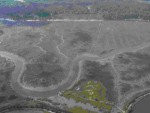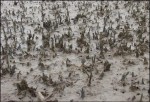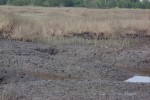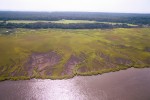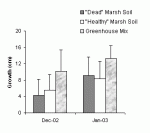Georgia Coastal Ecosystem LTER Investigators Approach Marsh Die-off
Reports of salt marsh dieback in Georgia began in the spring of 2002. There are now large areas of marsh with little or no live above-ground vegetation, and they have caused great concern along the Georgia coast as well as in South Carolina. All Georgia coastal counties are reporting marsh die-offs.
Although some dieback areas are showing signs of recovery (particularly small patches), others have shown no signs of regrowth since observations began a year ago. Current estimates exceed 1,000 affected acres, with both Spartina alterniflora (salt marsh cord grass) and Juncus romerianus (black needlerush) affected. Broadleafed plants (for example Borrichia frutescens) are not affected. Once the plants die their roots and rhizomes decompose, and in some areas the marsh is down to bare mud and beginning to slough into the water (Fig. 1).
Initial observations in Georgia of affected areas of marsh were made in October 2002 by a team from the Georgia Coastal Ecosystems (GCE) LTER program in conjunction with staff of the Coastal Resources Division of the Georgia Department of Natural Resources. The group surveyed transects at 3 sites exhibiting signs of dieback (one in an area that was completely devoid of vegetation and two that were only partially denuded) as well as at a nearby control site. Pore water salinities ranged from 21-36 in dieback areas and from 27-36 in the reference site; epifaunal snail and crab densities were variable and did not obviously relate to the die-off; and analysis of fungal populations did not indicate any unusual organisms (the report of this survey is available on the Georgia Coastal Research Council site: www.marsci.uga.edu/ coastalcouncil/marsh_dieback.htm.)
Of particular interest are the results of two greenhouse trials conducted by GCE investigator M. Alber with material collected from dieback areas. In the first trial, blocks of soil (approximately 25 cm2) containing Spartina alterniflora rhizomes were collected (see Fig. 1B), brought back to the greenhouse and watered regularly. None of these rhizomes resprouted. These observations were corroborated by histological analyses demonstrating that rhizomes from die-off areas are not viable (C. Franklin, Savannah State Univ., pers. comm.). These results suggest that, even if the causes of the die-off were removed and further damage did not occur (e.g. one early theory was that the die-off was related to drought and now that the area is receiving normal rainfall after a 5- year drought, recovery might be expected), the areas that have already been affected will not regenerate and will likely require replanting. We are therefore in danger of losing this habitat due to erosion (see Fig. 1C).
In the second greenhouse trial, healthy S. alterniflora seedlings, ranging in size from 5 - 15 cm, were transplanted into 5 replicate pots containing soil from either a dieback area or a nearby healthy marsh and growth was monitored for two months. All plants survived, and there was no difference in growth between treatments, suggesting that plants can survive in soil from a dieback site.
In keeping with this, live plants collected from the edge of the dead marsh site also survived in the greenhouse. These observations argue against the presence of a pollutant or pathogen in the soil, but these explanations cannot be completely ruled out because it is possible a pollutant was washed out during the greenhouse manipulation, or that a pathogen is transmitted through live plants or a biological vector and is short-lived outside the host.
GCE personnel are actively collaborating with the Georgia Coastal Research Council (see Box) as part of a state-wide effort to study marsh dieback. The Research Council has established a marsh monitoring protocol that is being used to collect information about dieback sites in a consistent, standardized way. At present, GCE personnel from the University of Georgia are working with scientists from the state DNR, the Sapelo Island National Estuarine Research Reserve, and Savannah State University to follow dieback patches through time.
There are also plans underway to include dieback areas on Sapelo Island as part of a remote sensing effort being conducted for the GCE. Finally, GCE personnel are continuing to work with transplants as the first step toward designing an appropriate restoration strategy for the State.
The Georgia marsh dieback phenomenon has been described in numerous local newspaper articles, and the issue was recently featured on NBC nightly news. It is not clear whether this die-off is the same as the brown marsh phenomenon that has occurred in the Gulf of Mexico. Although some aspects of the situation are similar (both occurred during periods of prolonged drought), there are also differences between the sites: plants in Louisiana go through a progressive color change, from green to brown, whereas in Georgia standing dead plants are not observed; die-off in Louisiana affects Spartina spp. but not J. romerianus, whereas in Georgia both are affected; dieback areas in Louisiana are often in the marsh interior, whereas in Georgia both creekbank and high marsh areas are affected.
The Research Council is currently working with the Georgia Sea Grant Program, the Louisiana Sea Grant Program, the Georgia State Department of Natural Resources and the Sapelo Island National Estuarine Research Reserve to organize a symposium for investigators from Louisiana, Georgia, and South Carolina. The symposium is planned for winter 2004.

 Enlarge this image
Enlarge this image